Now that I have your attention....
 A few days ago, I mentioned on a public observing forum that I was wondering what to observe next. My observing partner, Steve Gottlieb, immediately chirped "how about 25 galaxies within 10 degrees of Polaris". I remembered him mentioning such a project a month back, and learned that in fact he had observed this list very recently at Sierra Buttes, at 7200 feet elevation in the Sierra Nevada. So, I took up the challenge, and last night at Willow Springs I attempted the list. While Willow is only 2200 feet elevation, lacking the transparency benefits the Buttes has, it is a still a very good "local" sight, a mere 2 hours from my home in the south San Francisco bay area.
A few days ago, I mentioned on a public observing forum that I was wondering what to observe next. My observing partner, Steve Gottlieb, immediately chirped "how about 25 galaxies within 10 degrees of Polaris". I remembered him mentioning such a project a month back, and learned that in fact he had observed this list very recently at Sierra Buttes, at 7200 feet elevation in the Sierra Nevada. So, I took up the challenge, and last night at Willow Springs I attempted the list. While Willow is only 2200 feet elevation, lacking the transparency benefits the Buttes has, it is a still a very good "local" sight, a mere 2 hours from my home in the south San Francisco bay area.
A few words about the vagaries of this particular weekend - several of us were going to head to a friend's property near Yosemite to observe. The morning we were to leave, the weather forecast showed poor condition - potential thunderstorms, bad seeing and transparency.... we were unsure... weather reports are not always reliable. Then, as I was packing, I got a text message asking what I knew about the fire near Yosemite. Turned out, our destination was under evacuation warning, and choking in smoke. The ONLY fire in the entire state of California! Change of plans. We headed to Willow. Arriving there, the sky was filled with....
smoke.
From a new nearby fire!
Well, it was put out, and the sky cleared nicely. We enjoyed a fine evening observing, but it just goes to show, sometimes you just dodge a bullet ... and get lucky.
 So, the Pole Dancers. 21 galaxies Steve sent me in list form. Actually, in an article, but I'll leave the specifics of that to him to discuss. The galaxies were all within 5 degrees of Polaris, and varied from dancers you couldn't take your eyes off of, to those you barely knew were there, or cared. Of the 21, I had 19 confirmed, the remaining two were "suspected" at best - UGC 3661 and CGCG 363-039.
So, the Pole Dancers. 21 galaxies Steve sent me in list form. Actually, in an article, but I'll leave the specifics of that to him to discuss. The galaxies were all within 5 degrees of Polaris, and varied from dancers you couldn't take your eyes off of, to those you barely knew were there, or cared. Of the 21, I had 19 confirmed, the remaining two were "suspected" at best - UGC 3661 and CGCG 363-039.
I have to also note, I observe with an 18" f/4.5 Obsession, made in 1994. The mirror has its original coatings, and the only thing I've added is an Equatorial Platform, made by the master, Tom Osypowski. I love tracking, it makes the experience much more relaxed, and I feel I see much more not having to constantly worry about moving the scope at high power (note some of the eyepieces I use in this report). But, observing these targets, so close to the pole, I was able to turn off the drive, and just let the happy circumstance of being very close to the pole do the job of keeping my targets in the field of view. And.... I also never used my ladder, or moved my obseving chair. I could get used to watching pole dancing! ;-)
Finally, another great parts of a trip like this - with experienced and accomplished observers (included Mark Johnston and Richard Navarrete) - - - is sharing views. I've listed a few here in my report.
Thanks to Kevin Ritschel for hosting us at his property, great to see him again.... and thanks to Steve, for the project!
Here are my notes on the 21 Pole Dancers.
NGC 2268" 07 14 17.6 84 22 57 V = 11.5; Size 3.2'x2.0'; Surf Br = 13.4; PA = 63d
18" 7mm Obvious large elongated core in a slightly elongated e/w disk. Pinpoint nucleus comes can be held.. About 2'x1', fairly even gradual dimming from core to edges.
UGC 3528A = Arp 96 07 02 27.4 86 34 46 Size 0.8'x0.6'; PA = 63d
18" 7mm very dime pair with not much detail. Very close together, both have clear pinpoint nuclei, one closer to bright star has brighter obvious stellar nucleus. Both have indistinct hazy roundish disks. With 2x Barlow and 7mm, further out galaxy disk is bigger, brighter, and elongated N/S. Other galaxy disk is smaller, dimmer, and roundish.
UGC 3536A = Arp 96 07 03 22.0 86 33 28 V = 13.6; Size 0.7'x.0.6'; Surf Br = 12.7
18" 7mm very dime pair with not much detail. Very close together, both have clear pinpoint nuclei, one closer to bright star has brighter obvious stellar nucleus. Both have indistinct hazy roundish disks. With 2x Barlow and 7mm, further out galaxy disk is bigger, brighter, and elongated N/S. Other galaxy disk is smaller, dimmer, and roundish.
CGCG 362-033 = PGC 20191 07 08 15.1 86 39 29 Size 0.8'x0.3'; PA = 109d
18" 7mm w/2x Barlow - elongated SE/NW and 3x1 ratio. Inner 1x1 section is fairly even brightness, then falls off at extensions.
UGC 3654 = PGC 20601 07 17 47.1 85 42 48 V = 14.3; Size 0.4'x0.3'; Surf Br = 11.8; PA = 17d
18" 7mm w/2x Barlow - very small and nearly round, but slightly elongated. Dim stellar nucleus, elongation is N/S.
UGC 3661 = PGC 20655 07 19 45.0 85 46 01 Size 1.1'x0.25'; PA = 12d
18" 7mm w/2x Barlow - very fleeting view of just a small section of this thin galaxy.
UGC 3670 = PGC 20677 07 20 04.7 85 35 14 Size 1.0'x0.5'; PA = 40d
18" 4mm - very dim, elongated, even brightness, E/W elongation of about 3x1.
NGC 2276 = Arp 25 07 27 14.4 85 45 16 V = 11.4; Size 2.8'x2.7'; Surf Br = 13.5; PA = 20d
18" 7mm - fairly bright and obvious, compared to others this session. Round, fairly even brightness, mostly featureless except for small slightly brighter round core and dimmest of averted vision pinpoint nucleus.
NGC 2300 = Arp 114 07 32 20.0 85 42 32 V = 11.0; Size 2.8'x2.0'; Surf Br = 12.8; PA = 80d
18" 4mm - very bright very tight inner core with no discernible nucleus, and chaotic appearance. Quickly gives way to significantly dimmer outer core that extends at least three diameters of the inner core in diameter. Outer core extends over 1/2 way to brightest close star to the W. Possible HII to the SW. More possible HII toward pair of stars pointing away to the NNE.
sh2-71 nice detail! Viewed this in Steve Gottlieb's 18" Dob. With an OIII filter, much of the detail shown in this image was visible. The central star was very evident. Without the filter, the object took on a distinctly circular shape, was much less obvious - looked like an Abell Planetary, with an obvious central star. A very interesting object!
MCG 04-029 = PGC 21210 07 32 25.9 86 40 00 V = 14.3; Size 1.2'x0.6'; Surf Br = 13.8; PA = 45d
18" picked up with 12mm, off the end of a chain of four brighter stars framed at the target end by three collinear dimmer stars. Easy fin. Galaxy is small and elongated. The fact that the two collinear chains point into the field, make this a visually pleasing view with the galaxy as a highlight. Chains of stars are E/W, galaxy is mostly N/S, and seems to have brighter central section, and a bright knot to the S. Elongation is N/S.
IC 455 07 34 57.7 85 32 14 V = 13.3; Size 1.1'x0.7'; Surf Br = 12.9; PA = 82d
18" 7mm - picked up easily in 20mm, galaxy has a bright core and inner disk with apparent spiral arms extending
CGCG 362-045 = PGC 21817 07 48 01.0 85 33 07 Size 0.8'x0.6'; PA = 64d
18" 4mm - nice tight small core that appear chaotic. Occasionally a tiny bright pinpoint stellar nucleus appears. From core two close arms appear to extend only slightly, then a a larger disk that shows easily only on the side to S.
UGC 3993 = PGC 22202 07 55 44.0 84 55 35 V = 12.8; Size 1.6'x1.2'; Surf Br = 13.4; PA = 35d
18" 7mm- showed up at that magnification close to a tight uneven double star. Appears chaotic in its bright core..Entire core area is larger than first appeared, and even more disrupted - a dark intrusion? Surrounding is a large dim disk, more noticeable on the double star side.
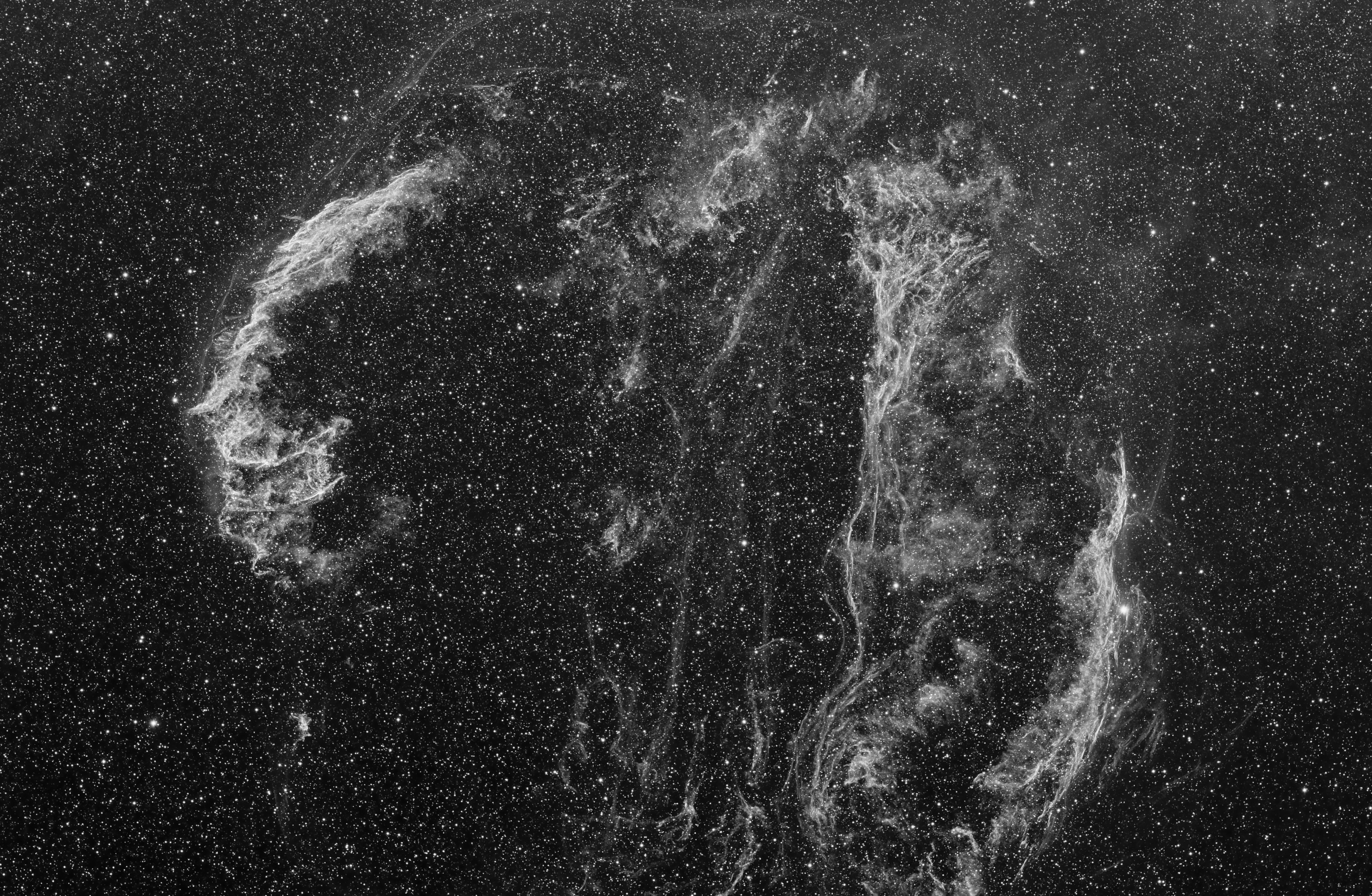 Binoculars with UHC and NPB on Veil, North American and Crescent. 15x50 stabilizers. The Veil looked very much like this photo in the binos - what a great view!
Binoculars with UHC and NPB on Veil, North American and Crescent. 15x50 stabilizers. The Veil looked very much like this photo in the binos - what a great view!
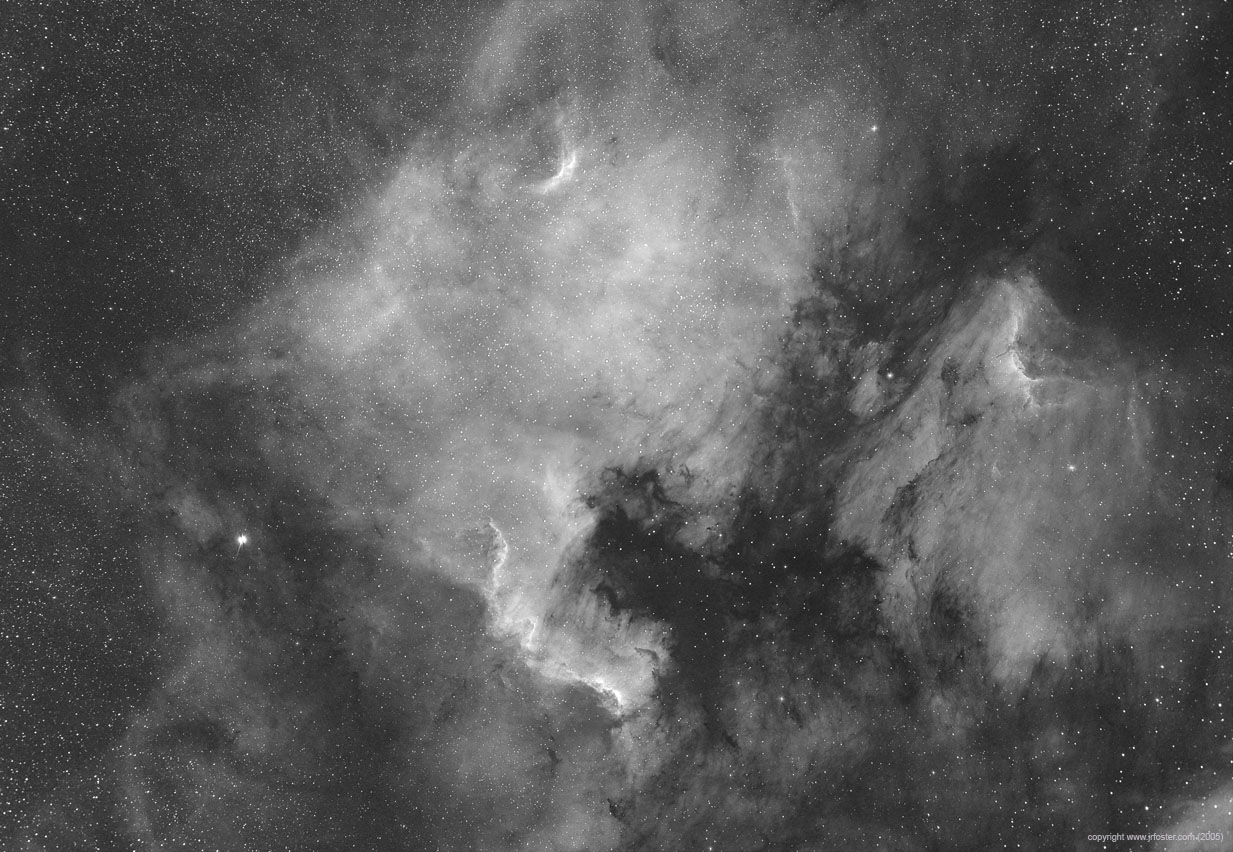 The North American stole the show in binoculars though, displaying its entire form, along with the Pelican Nebula, hands down the best view of this area I've ever seen. I swept over to the Crescent, which gave a nice view, but not comparable to that seen in a big Dob with a filter - and the entire Gamma Cygni area was filled with large clumps of glowing nebulae. Spectacular views in binoculars.
The North American stole the show in binoculars though, displaying its entire form, along with the Pelican Nebula, hands down the best view of this area I've ever seen. I swept over to the Crescent, which gave a nice view, but not comparable to that seen in a big Dob with a filter - and the entire Gamma Cygni area was filled with large clumps of glowing nebulae. Spectacular views in binoculars.
IC 469 07 55 59.1 85 09 32 V = 12.6; Size 2.2'x1.0'; Surf Br = 13.3; PA = 90d
18" 7mm- gives the impression of classic spiral galaxy tilted toward us, with mottled core area and possible sweeping arm in front, and large extended arms.
UGC 4078 = PGC 22640 08 04 24.7 84 38 29 V = 14.3; Size 2.1'x0.3'; Surf Br = 13.6; PA = 82d
18" 7mm - faint glow without central brightening. Three stars define the field, in a chain, bight and two dimmer, galaxy is off the side of center dimmer star. Galaxy seems to have hard edge or maybe dark lane on the side of the three stars. Very impressive maybe 6x1 ratio, and framed nicely in the center of three bright stars - bisecting them at a long angle.
CGCG 363-039 = PGC 23621 08 26 26.3 84 56 21 Size 1.0'x0.2'; PA = 130d
18" 7mm - this galaxy and one other small edge on proved to be the most challenging so far of the night - with only occasional "suspected" seeing a bit of it - a brightening between the two stars that flank it, and closer to the dimmer of the two.
UGC 4297 = PGC 23770 08 28 29.3 85 36 29 V = 13.6; Size 1.6'x0.4'; Surf Br = 12.9; PA = 83d
18" 7mm - bright,small, compact core with fleeting pinpoint nucleus. Core is uneven. Overall appearance is dim, but seems to have good extension, as does a dimmer elongated core.
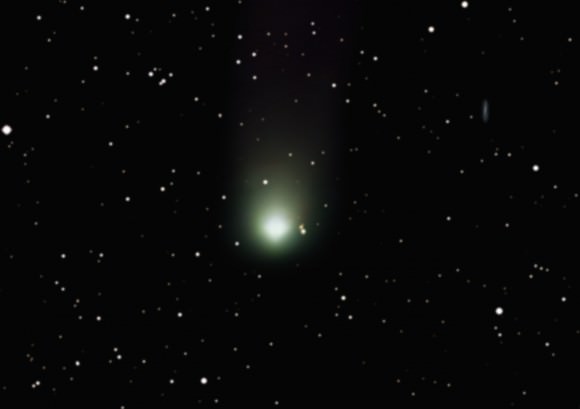 Comet in 6"refractor at low power- = bright comet, large even glow, core is tight with a very stellar nucleus.
Comet in 6"refractor at low power- = bright comet, large even glow, core is tight with a very stellar nucleus.
CGCG 363-041 = PGC 23961 08 33 39.0 85 58 57 V = 14.4; Size 0.7'x0.6'; Surf Br = 12.9
18" 4mm - very dim but part of close pair. By comparison it is brighter and smaller with slightly oval shape pointing mostly away on its major axis form its partner.
UGC 4348 = PGC 24001 08 34 01.9 85 56 44 V = 14.2; Size 1.5'x1.2'; Surf Br = 14.7; PA = 21d
18" 4mm - part of pair, but larger the its companion by comparison, dimmer, separated by a definite black void.
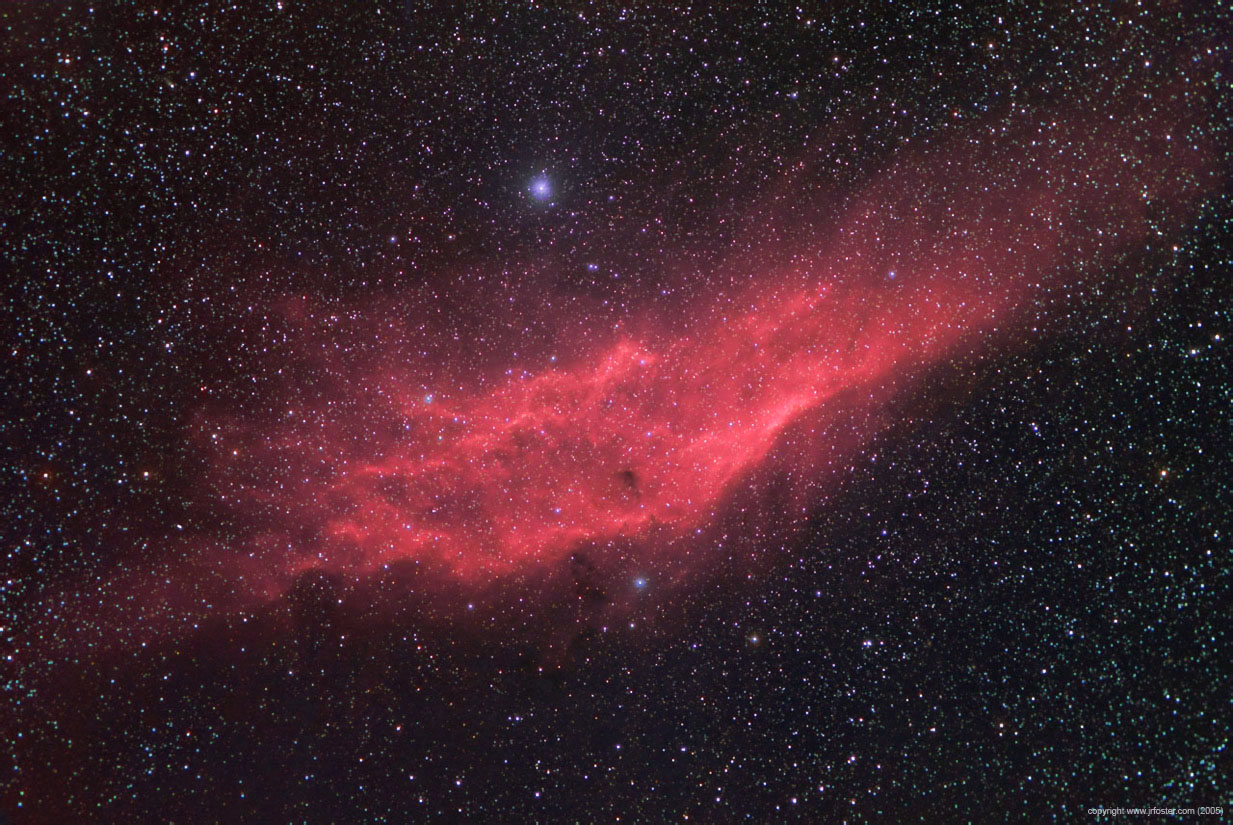 Thinking more about binocular views of the Veil and North American, I asked Steve about H-Beta filters. We came up with a pair, slapped them on, and easily found the California Nebula. The entire stretch of the object was visible, but of course it is quite tenuous, and while it did not have the "knock your eye out" impact of the others, there was no doubt we were seeing the entire target. Quite the sight.
Thinking more about binocular views of the Veil and North American, I asked Steve about H-Beta filters. We came up with a pair, slapped them on, and easily found the California Nebula. The entire stretch of the object was visible, but of course it is quite tenuous, and while it did not have the "knock your eye out" impact of the others, there was no doubt we were seeing the entire target. Quite the sight.
IC 499 08 45 16.9 85 44 24 V = 12.5; Size 2.1'x1.1'; Surf Br = 13.2; PA = 80d
18" 4mm - very dim and ghostly, much like an unknown phosphorescent deep water creature who's insides show through a dim clear body. Not quite round, but not enough elongation to call it distinctly oval. Very dim star just to one side gives impression of almost an annular planetary nebula.
IC 512 = UGC 4646 = PGC 25451 09 03 49.8 85 30 06 V = 12.2; Size 1.8'x1.3'; Surf Br = 13.0; PA = 175d
18" 4mm - I've been galaxy hopping in this eyepiece, and the 7mm. This galaxy is quit4e dim., shape is indistinct. Sometimes it appears round with a sharp edge, other times it appears to extend in an amorphous shape. Amorphous extension turns out to be UGC 4612.
Sunday, August 28, 2011
Pole Dancers
Posted by
Prana Ylem
at
5:20 PM
![]()
Subscribe to:
Post Comments (Atom)










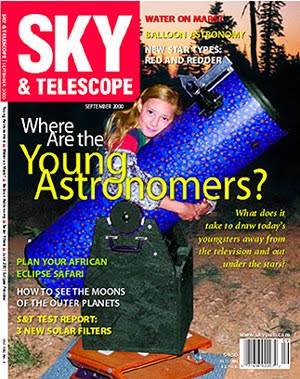
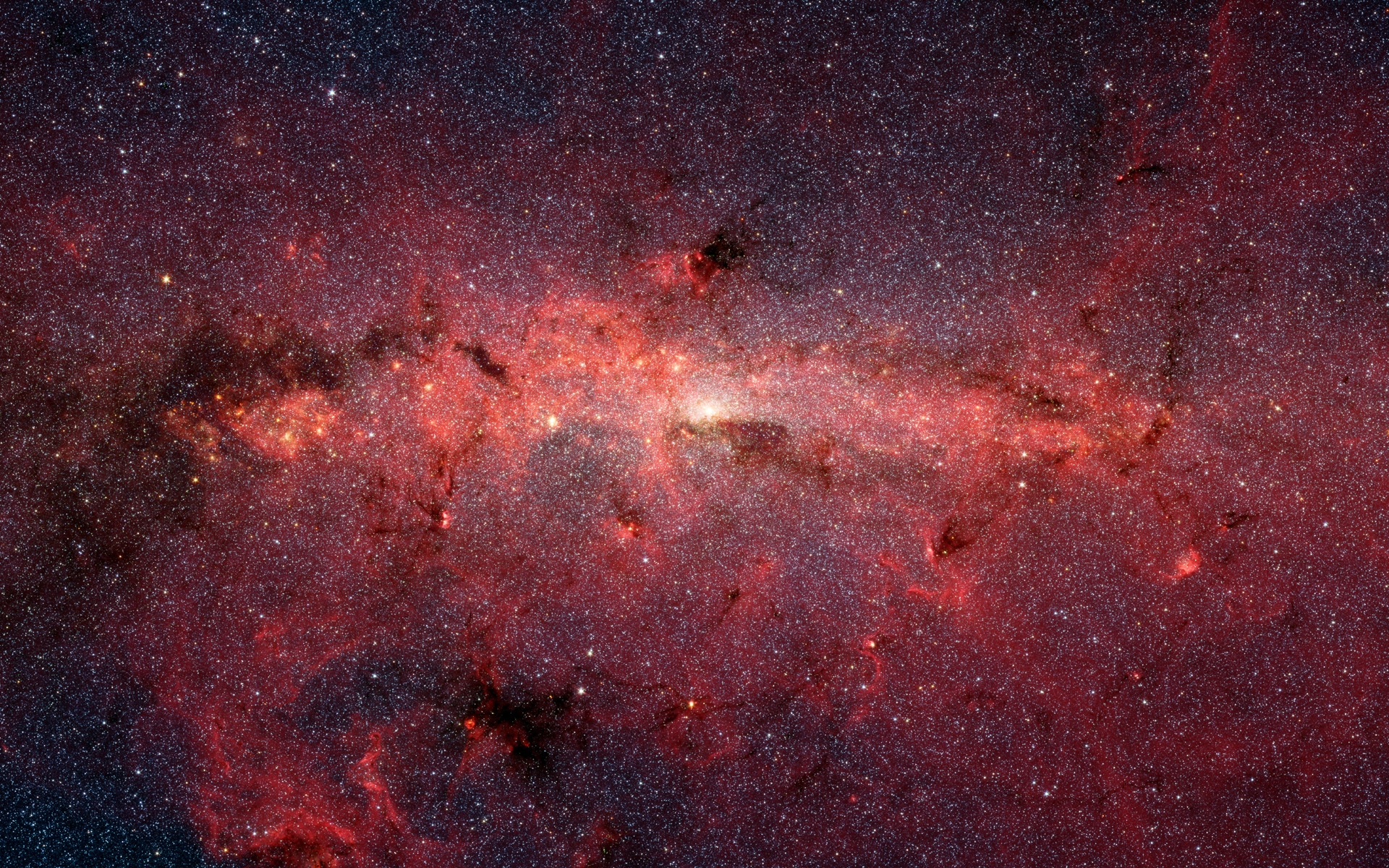
No comments:
Post a Comment